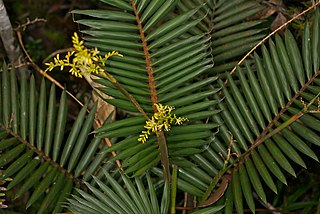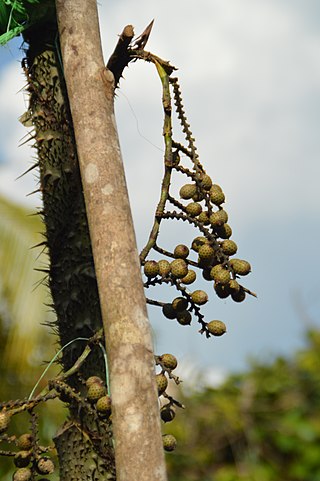
Rattan, also spelled ratan, is the name for roughly 600 species of Old World climbing palms belonging to subfamily Calamoideae. The greatest diversity of rattan palm species and genera are in the closed-canopy old-growth tropical forests of Southeast Asia, though they can also be found in other parts of tropical Asia and Africa. Most rattan palms are ecologically considered lianas due to their climbing habits, unlike other palm species. A few species also have tree-like or shrub-like habits.

Dragon's blood is a bright red resin which is obtained from different species of a number of distinct plant genera: Calamus spp. also including Calamus rotang, Croton, Dracaena and Pterocarpus. The red resin has been in continuous use since ancient times as varnish, medicine, incense, pigment, and dye.

Calamus is a genus of flowering plants in the palm family Arecaceae that is one of several genera known as rattan palms. There are an estimated 400 species in this genus, all native to tropical and subtropical Asia, Africa, and Australia.

Calamus gibbsianus is a species of rattan palm in the genus Calamus endemic to the Malaysian States of Sarawak and Sabah on the island of Borneo.

Calameae is a palm tree tribe in the subfamily Calamoideae. The type genus is Calamus and many of its members are rattans.

Ceratolobus was a dioecious genus of flowering plants in the palm family found in Southeast Asia, commonly called rotan. Its species are now included within the genus Calamus. They were only differentiated from Calamus and close relatives like Korthalsia by leaf sheath appendages or inflorescence variations. The Greek genus name combines "horn" and "capsule".

Calamus rotang, also known as common rattan, is a plant species native to India, Sri Lanka and Myanmar (Burma). It is one of the scandent (climbing) rattan palms used to make Malacca cane furniture, baskets, walking-sticks, umbrellas, tables and general wickerwork, and is found in Southwest Asia. The basal section of the plant grows vertically for 10 metres or so, after which the slender, tough stem of a few centimetres in diameter, grows horizontally for 200 metres or more. It is extremely flexible and uniform in thickness, and frequently has sheaths and petioles armed with backward-facing spines which enable it to scramble over other plants. It has pinnate, alternate leaves, 60–80 cm long, armed with two rows of spines on the upper face.

Calamoideae is a subfamily of flowering plant in the palm family found throughout Central America, South America, Africa, India, China, Southeast Asia and Australia. It is represented by 21 genera - containing nearly a quarter of all species in the palm family - including the largest genus, Calamus, the type genus of the group. Only four are found in the New World while the rest are Old World denizens, usually found in equatorial swampland or along tropical coastlines.
Climbing palms are genera in the family Arecaceae that grow as lianas. "Initially erect, the slender stems seek out trees for support and climb up into the forest canopy by means of recurved hooks and spines growing on the stem, leaves and inflorescences. In all climbing palms the leaves are pinnate and grow along the stem instead of forming a dense crown. The stems of climbing palms, more often referred to as canes, are solid in contrast to bamboo poles which are almost always hollow." "The majority of climbing palms are also clumping palms [and sympodial], sending out new shoots from [below ground as suckers]." "About 600 species of palms in [16] genera have a climbing growth habit. Most noteworthy is the genus Calamus--the largest genus in the palm family with approximately 350 described species--source of nearly all commercial rattan."
Calamus flagellum is an Asian species of tropical forest rattan liana in the family Arecaceae, with a native range from Assam to southern China and Indo-China. Its name in Vietnamese is mây song, while the Lepcha of Sikkim call it rim.
Calamus viminalis, one of many Calamus species commonly referred to as rattan, is a plant of the Arecaceae, or palm, family native to: Java and Bali in Indonesia; Peninsular Malaysia; all parts of Thailand; Cambodia; Cochinchina and Central Annam in Vietnam; all parts of Laos; Myanmar; Bangladesh; Andaman and Nicobar Islands; North-east, North-central, and South India; and probably north-west and south Yunnan in China.
Calamus tetradactylus is a climbing plant in the Arecaceae, or palm, family, and is part of a subfamily, Calamoideae, whose members are usually called rattans in English. It is native to southeast and east Thailand, Cambodia, Vietnam, south and central Laos, and Yunnan and elsewhere in southeast China. It grows in evergreen forest and scrub between 100 and 1,000m elevation. In Cambodia, it is described as a large and long rattan, its stalk growing from 20 to 70m long, growing in secondary formations near rivers.
Native to south Vietnam and Cambodia, Calamus salicifolius, is commonly referred to as a rattan, it is one of many Calamus species of the Arecaceae, or palm, family. It is described as a little bushy plant, often climbing, even on itself, with a 2 to 4m long stalk. It is found in deforested/severely degraded lowland areas and near houses, growing well in grasslands, scrub, roadside verges, ricefield bunds and peri-urban wastelands. Typically it occurs in floodplains with seasonal shallow flooding.
Part of a group, the subfamily Calamoideae, whose members are usually called rattans in English, Calamus godefroyi, is a climbing plant, and part of the Arecaceae, or palm, family.
Calamus bousigonii, is a liana, a climbing plant, and part of the Arecaceae, or palm, family. It is a member of the subfamily Calamoideae, whose members are usually called rattans in English,
Calamus poilanei is an Asian species of tropical forest rattan liana in the family Arecaceae. Its native range is Thailand, Laos, central and southern Vietnam and no subspecies are listed. Its name in Vietnamese is (mây) song bột, wai nampung in Thailand and wai khom or wai thoon in Laos.

Calamus draco is an Asian species of rattan plant in the family Arecaceae; its native range is from peninsular Thailand to western Malesia. It is a source of the red resin known as dragon's blood, which is a pigment with medicinal uses. The compound 4'-demethyl-3,9-dihydroeucomine (DMDHE), derived from the resin of Daemonorops draco, the homotypic synonym for Calamus draco, is a natural bitter-masking substance. This compound, which masks the bitter taste, suggests the importance for the food, beverage, and pharmaceutical industries to improve the taste and acceptability of foods and medicines.
Calamus thwaitesii is a species of rattan palm in the family Arecaceae. It is native to Southwest India and Sri Lanka.

Calamus manan, the manau rattan or rotan manau, is a species of flowering plant in the palm family Arecaceae, native to Thailand, Peninsular Malaysia, Sumatra, and Borneo. A vine, its single stem is widely harvested from the wild for cane furniture-making, leading to an unsustainable population decline. One unbranched stem at Buitenzorg, was carefully measured to a length of 787 feet.







